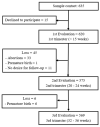Prevalence of Depression during Pregnancy in Spanish Women: Trajectory and Risk Factors in Each Trimester
- PMID: 34202666
- PMCID: PMC8297098
- DOI: 10.3390/ijerph18136789
Prevalence of Depression during Pregnancy in Spanish Women: Trajectory and Risk Factors in Each Trimester
Abstract
The aims of this research were to determine the trajectories of probable depression and major depression during pregnancy and to identify the associated and predictor variables (sociodemographic, pregnancy-related, and psychological) for both conditions in each trimester of pregnancy. A longitudinal study was carried out with 569 pregnant Spanish women who were assessed in the first, second, and third trimesters of pregnancy. Depression was assessed using the Edinburgh Postnatal Depression Scale and a clinical interview. Measures of anxiety and stress were also included. The prevalence of probable depression in the first, second, and third trimesters was 23.4%, 17.0%, and 21.4%, respectively, and that of major depression was 5.1%, 4.0%, and 4.7%. Thus, the prevalence of both conditions was the highest in the first and third trimesters. The trajectories of probable depression and major depression followed the same pattern throughout pregnancy. All of the psychological variables studied were associated with both conditions in all three trimesters, with perceived stress being a predictor at all times. The association between the other variables and both conditions of depression was similar. Two exceptions stand out: having had previous miscarriages, which was only associated with probable depression and was also a predictor, in the first trimester; and complications during pregnancy, which was only associated with probable and major depression in the third trimester. These findings should be taken into account in routine pregnancy follow-ups, and necessary interventions should be started in the first trimester.
Keywords: antenatal depression; pregnancy; prevalence; risk factors; trajectory.
Conflict of interest statement
The authors declare no conflict of interest.
Figures
References
-
- WHO Depresión. Datos y cifras [Depression. Data and numbers] [(accessed on 5 April 2019)]; Available online: https://www.who.int/es/news-room/fact-sheets/detail/depression.
-
- Bowen A., Muhajarine N. Antenatal depression. Can. Nurse. 2006;102:26–30. - PubMed
-
- Míguez M.C., Fernández V., Pereira B. Depresión postparto y factores asociados en mujeres con embarazos de riesgo [Postpartum depression and associated factors in women with at-risk pregnancies] Behav. Psychol. 2017;25:47–64.
MeSH terms
LinkOut - more resources
Full Text Sources
Medical



